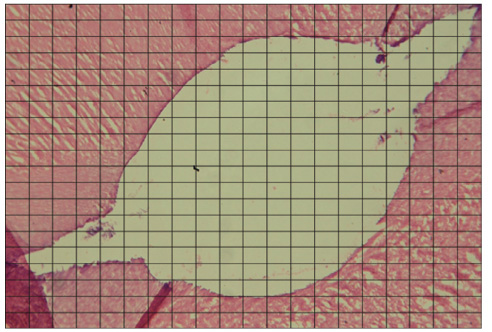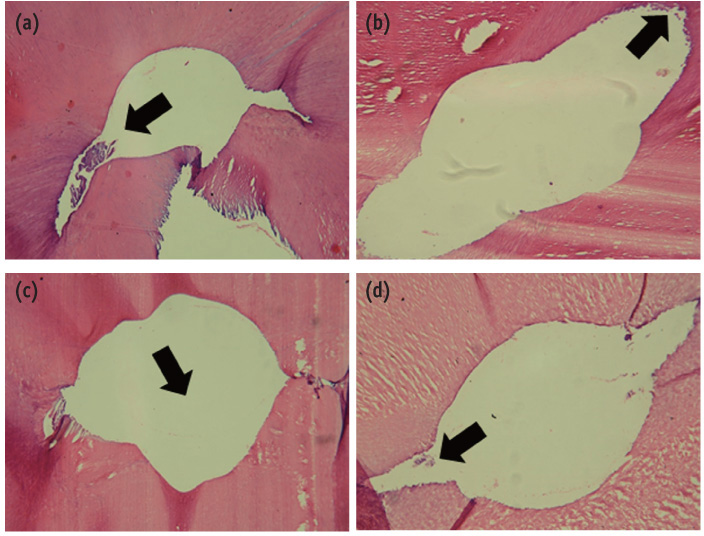Restor Dent Endod.
2014 May;39(2):104-108.
Effect of passive ultrasonic agitation during final irrigation on cleaning capacity of hybrid instrumentation
- Affiliations
-
- 1Department of Endodontics, School of Dentistry, Amazonas State University, Manaus, AM, Brazil.
- 2Department of Endodontics, School of Dentistry, Federal University of Amazonas, Manaus, AM, Brazil.
- 3Department of Dental Materials and Prosthodontics, Ribeirao Preto School of Dentistry, University of Sao Paulo, Ribeirao Preto, SP, Brazil. drlucas.garcia@gmail.com
Abstract
OBJECTIVES
To evaluate the effect of passive ultrasonic agitation on the cleaning capacity of a hybrid instrumentation technique.
MATERIALS AND METHODS
Twenty mandibular incisors with mesiodistal-flattened root shape had their crowns sectioned at 1 mm from the cementoenamel junction. Instrumentation was initiated by catheterization with K-type files (Denstply Maillefer) #10, #15, and #20 at 3 mm from the working length. Cervical preparation was performed with Largo bur #1 (Dentsply Maillefer) followed by apical instrumentation with K-type files #15, #20 and #25, and finishing with ProTaper F2 file (Denstply Maillefer). All files were used up to the working length under irrigation with 1 mL of 2.5% sodium hypochlorite (Biodynamica) at each instrument change. At the end of instrumentation, the roots were randomly separated into 2 groups (n = 10). All specimens received final irrigation with 1 mL of 2.5% sodium hypochlorite. The solution remained in the root canals in Group 1 for one minute; and ultrasonic agitation was performed in Group 2 for one minute using a straight tip inserted at 1 mm from working length. The specimens were processed histologically and the sections were analyzed under optic microscope (x64) to quantify debris present in the root canal.
RESULTS
The samples submitted to ultrasonic agitation (Group 2) presented significant decrease in the amount of debris in comparison with those of Group 1 (p < 0.05).
CONCLUSIONS
The hybrid instrumentation technique associated with passive ultrasonic agitation promoted greater debris removal in the apical third of the root canals.
Keyword
MeSH Terms
Figure
Reference
-
1. Gonçalves LC, Junior EC, da Frota MF, Marques AA, Garcia Lda F. Morphometrical analysis of cleaning capacity of hybrid instrumentation in mesial flattened root canals. Aust Endod J. 2011; 37:99–104.2. Arruda MP, Carvalho Junior JR, Miranda CE, Paschoalato C, Silva SR. Cleaning of flattened root canals with different irrigating solutions and nickel-titanium rotatory instrumentation. Braz Dent J. 2009; 20:284–289.
Article3. Ferreira RB, Alfredo E, Porto de Arruda M, Silva-Sousa YT, Sousa-Neto MD. Histological analysis of the cleaning capacity of nickel-titanium rotatory instrumentation with ultrasonic irrigation in root canals. Aust Endod J. 2004; 30:56–58.
Article4. Sasaki EW, Versiani MA, Perez DE, Sousa-Neto MD, Silva-Sousa YT, Silva RG. Ex vivo analysis of the debris remaining in flattened root canals of vital and nonvital teeth after biomechanical preparation with Ni-Ti rotatory instruments. Braz Dent J. 2006; 17:233–236.
Article5. Farid H, Khan FR, Rahman M. ProTaper rotary instrument fracture during root canal preparation: a comparison between rotary and hybrid techniques. Oral Health Dent Manag. 2013; 12:50–55.6. Nadalin MR, Perez DE, Vansan LP, Paschoala C, Sousa-Neto MD, Saquy PC. Effectiveness of different final irrigation protocols in removing debris in flattened root canals. Braz Dent J. 2009; 20:211–214.
Article7. Rasquin LC, de Carvalho FB, Lima RK. In vitro evaluation of root canal preparation using oscillatory and rotary systems in flattened root canals. J Appl Oral Sci. 2007; 15:65–69.
Article8. Kottoor J, Velmurugan N, Gopikrishna V, Krithikadatta J. Effects of multiple root canal usage on the surface topography and fracture of two different Ni-Ti rotary file systems. Indian J Dent Res. 2013; 24:42–47.
Article9. Baratto-Filho F, de Carvalho JR Jr, Fariniuk LF, Sousa-Neto MD, Pécora JD, da Cruz-Filho AM. Morphometric analysis of the effectivenes of diferent concentrations of sodium hypochlorite associated with rotary instrumentation for root canal cleaning. Braz Dent J. 2004; 15:36–40.
Article10. Ribeiro EM, Silva-sousa YT, Souza-Gabriel AE, Sousa-Neto MD, Lorencentti KT, Silva SR. Debris and smear removal in flattened root canals after use of different irrigant agitation protocols. Microsc Res Tech. 2012; 75:781–790.
Article11. Marchesan MA, Arruda MP, Silva-Sousa YT, Saquy PC, Pecora JD, Sousa-Neto MD. Morphometrical analysis of cleaning capacity using nickel-titanium rotary instrumentation associated with irrigating solutions in mesio-distal flattened root canals. J Appl Oral Sci. 2003; 11:55–59.
Article12. da Frota MF, Filho IB, Berbert FL, Sponchiado EC Jr, Marques AA, Garcia Lda F. Cleaning capacity promoted by motor-driver or manual instrumentation using Protaper Universal system: histological analysis. J Conserv Dent. 2013; 16:79–82.
Article13. Zmener O, Pameijer CH, Alvarez Serrano S, Hernandez SR. Cleaning efficacy using two engine-driven systems versus manual instrumentation in curved root canals: a scanning electron microscopic study. J Endod. 2011; 37:1279–1282.
Article14. Moura-Netto C, Palo RM, Camargo CH, Pameijer CH, Bardauil MR. Micro-CT assessment of two different endodontic preparation systems. Braz Oral Res. 2013; 27:26–30.
Article15. Yoo YS, Cho YB. A comparison of the shaping ability of reciprocating NiTi instruments in simulated curved canals. Restor Dent Endod. 2012; 37:220–227.
Article16. Lim YJ, Park SJ, Kim HC, Min KS. Comparison of the centering ability of Wave·One and Reciproc nickel-titanium instruments in simulated curved canals. Restor Dent Endod. 2013; 38:21–25.
Article17. Grecca FS, Garcia RB, Bramante CM, Moraes IG, Bernardineli N. A quantative analyses of rotary ultrasonic and manual techniques to treat proximally flattened root canals. J Appl Oral Sci. 2007; 15:89–93.
Article18. Esposito PT, Cunningham CJ. A comparison of canal preparation with nickel-titanium and stainless steel instruments. J Endod. 1995; 21:173–176.
Article19. Arya A, Bali D, Grewal MS. Histological analysis of cleaning efficacy of hand and rotary instruments in the apical third of the root canal: a comparative study. J Conserv Dent. 2011; 14:237–240.
Article20. Mozo S, Llena C, Forner L. Review of ultrasonic irrigation in endodontics: increasing action of irrigating solutions. Med Oral Patol Oral Cir Bucal. 2012; 17:e512–e516.
Article21. van der Sluis LW, Versluis M, Wu MK, Wesselink PR. Passive ultrasonic irrigation of the root canal: a review of the literature. Int Endod J. 2007; 40:415–426.
Article22. Gu LS, Kim JR, Ling J, Choi KK, Pashley DH, Tay FR. Review of contemporary irrigant agitation techniques and devices. J Endod. 2009; 35:791–804.
Article23. Tasdemir T, Er K, Celik D, Yildirim T. Effect of passive ultrasonic irrigation on apical extrusion of irrigating solution. Eur J Dent. 2008; 2:198–203.
Article
- Full Text Links
- Actions
-
Cited
- CITED
-
- Close
- Share
- Similar articles
-
- Impact of different agitation methods on smear layer cleaning of mesial canals with accentuated curvature
- Review of root canal irrigant delivery techniques and devices
- In vitro evaluation of cleaning efficacy of various irrigation methods in mandibular molars
- Multivariate analysis of the cleaning efficacy of different final irrigation techniques in the canal and isthmus of mandibular posterior teeth
- Effect of three different irrigation solutions applied by passive ultrasonic irrigation



